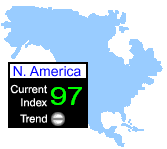Which one is the US Open record?
Times in swimming seem like immutable things. The clock starts by the visual, aural, and electronic signal of the starting console, and the clock is (typically) stopped by the swimmers contact with the touchpad. Of course, it actually isn't that simple--all kinds of things can go wrong with the timing system, and there are many complexities. But for most swimmers, the process I described is the process that happens.
Setting records is another matter. When a swimmer sets a high level (US Open, American, World) record, there has to be a bunch of paperwork, plus the pool has to be measured to make sure it is the correct distance (don't laugh!), and the swimmer often has to go through a drug test. And then sometimes, records can be tossed out for seemingly arbitrary reasons (don't tell me that FINA GR 9.6.1.2 was your reason).
There are two kinds of records that indicate the fastest swim in the United States. The American record is the fastest time swum by a United States citizen anywhere. The United States Open record is the fastest swum by anyone on US soil. Of course, the former receives more attention than the latter, but it doesn't mean the latter isn't important. But still, deciding whether a swim is a record isn't as trivial as it seems.
To emphasize that this process isn't as easy as it looks, let's take a look a look at the Women's 50 meter backstroke US Open record in long course (so one length of the pool in a 50 meter pool). I'll give three choices:
- 28.86, 13 August 2002, Natalie Coughlin, 2002 Phillips 66 (Summer) National Championships, Fort Lauderdale, Florida
- 28.90, 16 February 2007, Lauren English, Missouri Grand Prix, Columbia, Missouri
- 29.01, 6 August 1998, Natalie Coughlin, Concord, California
So which one is the record? According to USA Swimming, it's still that 29.01 effort from 1998. It's so old that finding the results for that effort is a lost cause--it's next to impossible even to know what meet it was at. I'll assume for the purposes of this discussion that it's at least a candidate. It's been on the books for nearly ten years...at least, as it appears.
So let's look at that 28.86, the fastest of the bunch. If you look at the results, the swim was actually the first leg of Natalie Coughlin's 59.58 then-world record effort in the 100 Back (28.86 for the first 50, 30.72 coming back). Since the whole swim was a ratified world record swim, we know a few things: namely that the pool was at least 50 meters long and measured, that the paperwork was processed for that part, and that Coughlin passed through doping control. And there's some support for this performance. I mean, it's the fastest time, why wouldn't it be the record?
But seeing the results of this swim reminded me of one issue very specific to backstroke swims: A backstroke turn is not necessarily (and for most swimmers, is not) a legal backstroke finish. Since most swimmers employ the flip turn on the stomach, the finish of Coughlin's first length probably was her rolling onto her stomach, performing a flip, and touching with her feet (which was certainly a legal turn in 2002, as it is today). But the finish must be on the back, and that means that an initial distance for record must also have that same finish. It's why the USA Swimming Rules & Regulations says this (emphasis added):
102.16.4A(1) An official time can be achieved only in USA Swimming sanctioned or USA Swimming approved competition, or in an observed swim in accordance with all applicable rules. It may be achieved in: ... (d) A split time recorded from the official start to the completion of an initial distance with a legal finish within a longer event, provided the swimmer completes the event or the lead-off portion of the relay in compliance with applicable rules.In order for this to happen, the turn judge would have had to be looking for the legal finish at the halfway point. Could it have happened? Certainly, but the official would have had to been alerted to this issue. In the end we don't know whether this happened, but it could be the reason why this performance isn't the record.
So that leaves us with the 28.90 in the middle. The event was a 50 meter backstroke, so there's no need to worry about a legal finish if the swimmer wasn't disqualified (which didn't happen). It's probable (although it's possible to be otherwise) that the pool was of the right length, as Michael Phelps set a world record the next day which was ratified. We don't know whether the swimmer passed the drug tests, if they were administered. But my feeling is that, for now, this should be the reigning US Open record in this event, until someone else comes along and breaks it.
METAR KIGX 0156Z VRB04KT 10SM CLR 13/M01 A2997 RMK SLP147Labels: swimming





0 Comments:
Post a Comment
<< Home